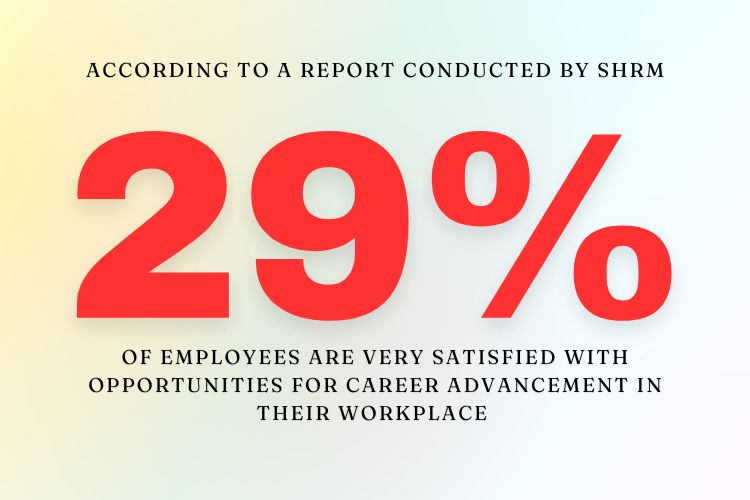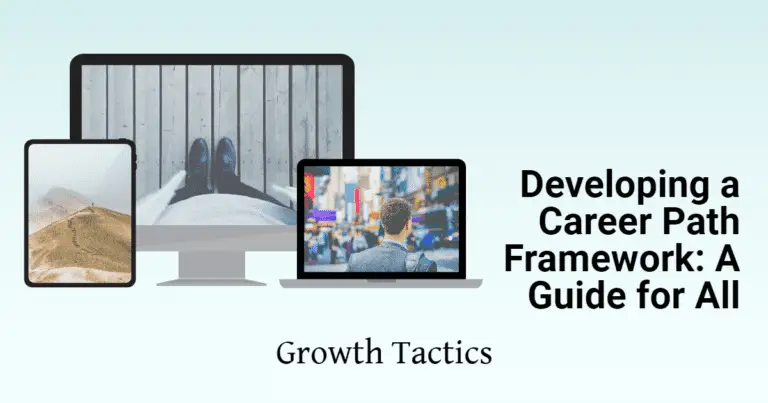Looking to move up the career ladder but not sure how? Or are you an employer trying to support your employees’ career growth? Whatever your case may be, developing a career path framework is an essential step toward achieving your goals. In this article, we’ll cover everything from understanding what a career path framework is to crafting an effective one that benefits both employees and employers.
Jump To Section
What is a Career Path Framework?
What is a Framework?
First, let’s define the framework. A framework is a structure you can use to guide your thinking and actions. It’s like the skeleton that supports everything else. It’s useful because it gives structure to what you’re doing, it keeps it organized, and it helps you to think systematically.
What is a Career Path?
A career path is the sequence of jobs, roles, and experiences an employee may have over time. It’s how people develop their skills and advance to new roles and responsibilities. In essence, a career path is like a roadmap that helps employees navigate their careers.
What is a Career Path Framework?
Now let’s put them together. A career path framework is an organized and structured approach to career development. It’s a tool that delineates the steps, milestones, and experiences an employee needs to achieve their career goals. A career path framework helps employees see where they are, where they want to go, and how they can get there.
Why Do You Need a Career Path Framework?

Benefits for Employees
A career path framework helps employees to:
- Understand their current career level.
- Map out a career map that aligns with their personal and professional goals.
- Tailor their career progression by identifying development opportunities.
- Show growth opportunities and career advancement to employees who want to develop their skills.
- Identify and promote good performance.
- Retain employees by building and strengthening loyalty.
- Support long-term career goals.
Benefits for Employers
A career path framework supports employers by:
- Building a framework that shows employees how to progress within the company.
- Providing career development opportunities, which are a significant factor in employee engagement.
- Helping managers and employees to have periodic career discussions.
- Tailoring their talent management programs adequately.
- Identifying advancement opportunities.
- Providing opportunities and benefits for high-performing employees.
- Demonstrating career opportunities externally to attract top performers.
- Retaining employees by creating a solid career progression framework.
How to Develop a Career Path Framework
1. Start with the End Goal in Mind
Crafting a career progression framework begins with specific careers and recognizes the skills, knowledge, and experience skills needed to reach that goal. This practice benefits both the employees and the organization. Employees can better understand the skills and competencies required for specific job titles and learn ways to achieve them. At the same time, organizations can determine the areas where they need to provide development opportunities to help their employees succeed.
2. Identify Key Career Paths
Identifying key career paths is the next step in developing a career path framework. Employers should have clarity about the kinds of career progression opportunities available within their organization and communicate them regularly. Doing so helps employees gain a clear understanding of how they can progress within the company.
3. Create a Career Pathing Framework Template
Creating a career pathing framework template will help both employees and employers to organize their thinking and actions around career development. A well-defined framework can serve as a guide to career progression for employees and as a tool for managers to support employee growth. An effective career pathing framework should include clear and actionable steps for employees to get to the next level.
4. Implement Career Development Plans
Implementing career development plans is the critical next step. Managers and employees should work together to create an effective career development plan. It should be based on the career pathing framework template and should consider the employees’ current career, their skills and competencies, and long-term career goals.
5. Monitor and Review Progress
Finally, progress monitoring and review of career development plans are critical to success. An annual performance review doesn’t provide enough context for understanding career development opportunities and challenges in real time. Instead, managers should meet with employees periodically to assess career progress, modify and update career development plans, and identify new opportunities as they arise.
Developing a Career Path Framework: What to Include
In this section, we’ll explore the essential elements that should be incorporated into a comprehensive career path framework.
Job Levels and Titles
At the heart of a career path framework are the different job levels and titles within your organization. Clearly define the progression from entry-level positions to senior management roles. This hierarchy will help employees understand the various stages of their career journey.
Competencies and Skills
Identify the key competencies and skills required for each level and role in your organization. This encompasses both technical expertise and soft skills. Clearly outline the specific knowledge and abilities that employees need to develop as they advance in their careers.
Development Opportunities
A career path framework should provide a roadmap for employees to acquire the necessary skills and experiences to progress. Outline the development opportunities available, such as training programs, mentorship initiatives, and challenging assignments. These opportunities will support employees in their growth and empower them to take the reins of their career development.
Performance Expectations
To excel in their current roles and prepare for future advancements, employees need to understand the performance expectations. Define the criteria and standards for success at each level. This clarity enables employees to align their efforts and focus on continuously improving their performance.
Succession Planning
Integrating succession planning into your career path framework helps identify high-potential employees and prepares them for future leadership roles. Identify employees who show promise and provide them with the necessary resources and development opportunities to groom them for key positions. This ensures a robust talent pipeline and facilitates smooth transitions during organizational changes.
Feedback and Evaluation
Regular feedback and evaluation processes play a crucial role in employee development. Establish a culture of ongoing feedback and support. Provide employees with constructive feedback and identify areas for improvement. This regular dialogue fosters continuous learning and growth.
External Opportunities
While it’s important to focus on internal career progression, it’s also beneficial to consider external opportunities. Encourage employees to explore different career paths within or outside the organization. Provide guidance on how they can leverage their skills and experiences to navigate external avenues for career advancement.
Continuous Learning
Promote a culture of continuous learning by emphasizing its importance in your career path framework. Encourage employees to engage in professional development activities, attend industry conferences, and seek out opportunities to expand their knowledge and skills. Investing in ongoing learning ensures that employees stay relevant and adaptable in a rapidly changing business landscape.
By incorporating these elements into your career path framework, you’ll empower your employees to take control of their professional growth and create a supportive environment that nurtures their careers.
How to Use a Career Progression Framework for Success
Start with Self-Assessment
Using a career progression framework is an excellent way to map out your professional growth and achieve success in your career. But where do you begin? The first step is to engage in self-assessment. Take the time to reflect on your interests, strengths, and areas for improvement. This will help you identify the career path that aligns with your goals and aspirations.
Understand the Framework
Once you have a clear sense of your career goals, familiarize yourself with the career progression framework established by your organization. Study the defined job levels and titles, as well as the competencies and skills required at each stage. This understanding will serve as your roadmap to success.
Set Clear Goals
Using the career progression framework as a guide, set specific goals for yourself. Determine what level you aim to reach within the organization and identify the skills and experiences you need to acquire to get there. By setting clear goals, you create a sense of purpose and direction in your career journey.
Seek Development Opportunities
Take advantage of the development opportunities outlined in the career progression framework. Engage in training programs, participate in mentorship initiatives, and actively seek out challenging assignments. These opportunities will help you acquire the necessary skills and experiences to progress in your career.
Take Ownership of Your Development
Using a career progression framework doesn’t mean sitting back and waiting for opportunities to come your way. Take ownership of your professional growth. Seek feedback from your supervisors, actively seek out learning opportunities, and network both internally and externally. Show initiative and demonstrate to your organization that you are committed to your career advancement.
Regularly Assess Your Progress
To ensure you are on track with your career progression, it’s essential to regularly assess your progress. Reflect on your achievements, evaluate your skill development, and identify any areas where you need to improve. This self-assessment will help you make any necessary adjustments to stay aligned with your goals.
Seek Feedback and Guidance
Don’t be afraid to seek feedback from supervisors, mentors, and colleagues. Solicit their insights on your performance, strengths, and areas for development. This feedback will provide valuable guidance as you navigate your career journey and help you make informed decisions on your development.
Adapt and Evolve
Remember that career progression is not a linear path. Be open to change and adaptation. Embrace new opportunities and challenges that come your way. Stay curious, continually learn, and be flexible in adjusting your goals as you gain new insights and experiences.
Celebrate Milestones
Lastly, celebrate your achievements along the way. Each milestone reached in your career progression is worth acknowledging. Take the time to recognize your hard work and accomplishments. Celebrating your successes will fuel your motivation and inspire you to reach for even greater heights.
Using a career progression framework effectively is all about taking ownership of your professional development, setting clear goals, seeking opportunities for growth, and adapting to the ever-evolving business landscape. By following these steps, you’ll be well on your way to achieving success and fulfillment in your career.
Key Takeaways
- A career path framework is an organized and structured approach to career development.
- Both employees and employers benefit from developing a career path framework.
- Crafting a career path framework begins with specific careers and recognizes the skills, knowledge, and experience needed to reach that goal.
- Career pathing framework templates help to organize thinking and actions around career development.
- Career development plans should be based on the career pathing framework template and should consider employees’ current careers, their skills and competencies, and long-term career goals.
- Progress monitoring and review of career development plans are critical to success.
We hope this guide helps you to develop a career path framework that supports and benefits both employees and employers. Remember, a career path framework is an investment in your career, and its impact can span a lifetime.


